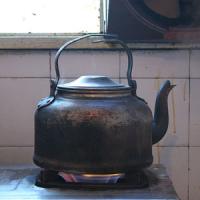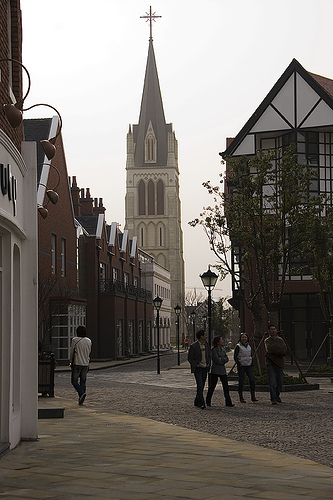China’s Gambling Fever

One of China’s most popular cultural exports, aside from its now ubiquitous cuisine, is the game of Mah Jong, a game played with tiles a little larger than dominoes and similar in its basic concept to Gin Rummy. Popular as this game is both inside and outside of China, many non-Chinese aren’t aware that the game is at heart a gambling game, for the Chinese love to gamble.
This might seem something of a glib thing to say, as gambling and betting are popular all over the world. But for whatever reason, gambling seems to be especially popular among Chinese. In 2006 global gambling companies earned a totally of 10 billion euros from wagers on World Cup, 60 percent of which came from mainland China and Southeast Asia (1). When you consider that there are 1.3 billion people in China, it might seem only natural that such a large portion of World Cup wagers should have been made there. But on the other hand, the average salary of a Chinese person is just 1,250 euros ($1,700) a year (2). The world’s wealth may be concentrated outside of China, but its betters aren’t.
China has a long history of gambling and lotteries. The first state lotteries were held during the Tang Dynasty, and in fact state lotteries were used in part to finance the building and maintenance of the Great Wall (3). Today however gambling is illegal in China. There are a few small-scale exceptions: in Shanghai there are a few lotteries and several hundred keno gambling outlets whose proceeds benefit a state-sponsored welfare fund (4). But for serious gambling, the Chinese go abroad or to Macao, and those who cannot afford to go to these places go under ground.
Since Portugal returned Macao to China in 1999, gambling has grown into an enormous and enormously profitable industry there. Last year 22 million visitors came to Macao’s gambling tables, and Macao is now a bigger gambling destination than Las Vegas in terms of total revenue, pulling in $6.95 billion in 2006. Given Macao’s tiny size, that means that tables in Macao actually pull in about seven times more money than those in Las Vegas (2). What’s more, in Las Vegas itself the two week period of Chinese New Year is one of the most profitable times of the year for casinos, and a time when per-player betting is just about as high as it ever gets (7).
But, profitable though Macao and China’s few other legalized means of gambling are, legal gambling in China and Macao accounts for only a tiny fraction of the industry. It’s estimated that in 2006 the Chinese spent 800 billion yuan ($104 billion) on illegal and overseas gambling, which amounts to ten times that spent on state lotteries (5). In one bust in January 2005 the government arrested nearly 600 people for illegal Internet gambling and seized 243 million yuan ($31.5 million) (6). In 2006 the government reported a total of 380,000 gambling cases across the country, involving some 1.25 million people and 4.8 billion yuan ($620 million) (5).
Aside from the popularity of gambling in Chinese culture, one reason for the prevalence of illegal gambling may be that the penalties are simply not harsh enough to act as a deterrent; the most severe penalty for gambling is a three-year prison sentence. (1) And if you compare the amount people gamble illegally (800 billion) to the amount the police seized (4.8 billion) (something of a poor comparison it’s true, as the amount gambled and the number of people involved have little to do with each other) you may decide that odds are pretty good that you’ll get away with it.


 In 2006, Shanghaiist
In 2006, Shanghaiist 
 Yep. At least that is what
Yep. At least that is what 
 The giant panda is high on the endangered species list; only a few thousand of these unique animals remain, all in Gansu, Sichuan and Shaanxi provinces. The Chinese government is making great efforts to increase their numbers. The Chengdu Panda Breeding Center constitutes one such effort. The 92 acre center is dedicated to providing pandas, and many other endangered species, with natural surroundings so that they can multiply. Plans are in place to add over 500 acres to the enclosure. The hope is that the center will achieve not only successful breeding plan, but that the enclosure will be large enough to simulate the wild so that the pandas can one day be released back into their natural home. The area was added to the
The giant panda is high on the endangered species list; only a few thousand of these unique animals remain, all in Gansu, Sichuan and Shaanxi provinces. The Chinese government is making great efforts to increase their numbers. The Chengdu Panda Breeding Center constitutes one such effort. The 92 acre center is dedicated to providing pandas, and many other endangered species, with natural surroundings so that they can multiply. Plans are in place to add over 500 acres to the enclosure. The hope is that the center will achieve not only successful breeding plan, but that the enclosure will be large enough to simulate the wild so that the pandas can one day be released back into their natural home. The area was added to the 





 With all the excitement of the
With all the excitement of the  Last week,
Last week,  In China, you will see slogans every day and everywhere. Not only is this a tradition with a long history, it is a trend that has remained popular, particularly in the red and crazy 1950s - 1970s.
In China, you will see slogans every day and everywhere. Not only is this a tradition with a long history, it is a trend that has remained popular, particularly in the red and crazy 1950s - 1970s. 
 Many, if not most, of the clothes, electronics and household goods for sale on Western shelves are made in China. According to China Today, sixty to seventy percent of formal eveningwear supplied to the world is produced in a single factory in Chaozhou, Guangdong Province (1)! The figures are difficult to grasp, but their effects on shopping in China are immediately obvious: Chinese workers learn to make the real thing, and then they start making counterfeits by the ton.
Many, if not most, of the clothes, electronics and household goods for sale on Western shelves are made in China. According to China Today, sixty to seventy percent of formal eveningwear supplied to the world is produced in a single factory in Chaozhou, Guangdong Province (1)! The figures are difficult to grasp, but their effects on shopping in China are immediately obvious: Chinese workers learn to make the real thing, and then they start making counterfeits by the ton. Shanghaiist thinks there aren’t enough cars in Shanghai. The air, quite frankly, is incredibly clean. There’s nary a spot of traffic. And really, couldn’t taxi drivers be more conscientious by honking their horns just a LITTLE more often? Shanghai needs more cars. Definitely. And what better place to encourage additional consumption than the Shanghai Auto Show!
Shanghaiist thinks there aren’t enough cars in Shanghai. The air, quite frankly, is incredibly clean. There’s nary a spot of traffic. And really, couldn’t taxi drivers be more conscientious by honking their horns just a LITTLE more often? Shanghai needs more cars. Definitely. And what better place to encourage additional consumption than the Shanghai Auto Show!  The growth of green. Hybrid vehicles from both Chinese and American firms were everywhere. GM and VW even showcased concept fuel cell-powered cars. What does it mean? Instead of setting high car prices (like in Singapore) or pricing roads to limit driving (like in London) the government is targeting “green vehicles” as the best way to reduce emissions. Yes, Virginia, cars and trucks produce most of Shanghai's air pollution.
The growth of green. Hybrid vehicles from both Chinese and American firms were everywhere. GM and VW even showcased concept fuel cell-powered cars. What does it mean? Instead of setting high car prices (like in Singapore) or pricing roads to limit driving (like in London) the government is targeting “green vehicles” as the best way to reduce emissions. Yes, Virginia, cars and trucks produce most of Shanghai's air pollution. A private detective, hired by the wife of a Shenzhen businessman, successfully tracked down the latter's mistress—a third year university student. What he didn't expect was the neatly folded
A private detective, hired by the wife of a Shenzhen businessman, successfully tracked down the latter's mistress—a third year university student. What he didn't expect was the neatly folded